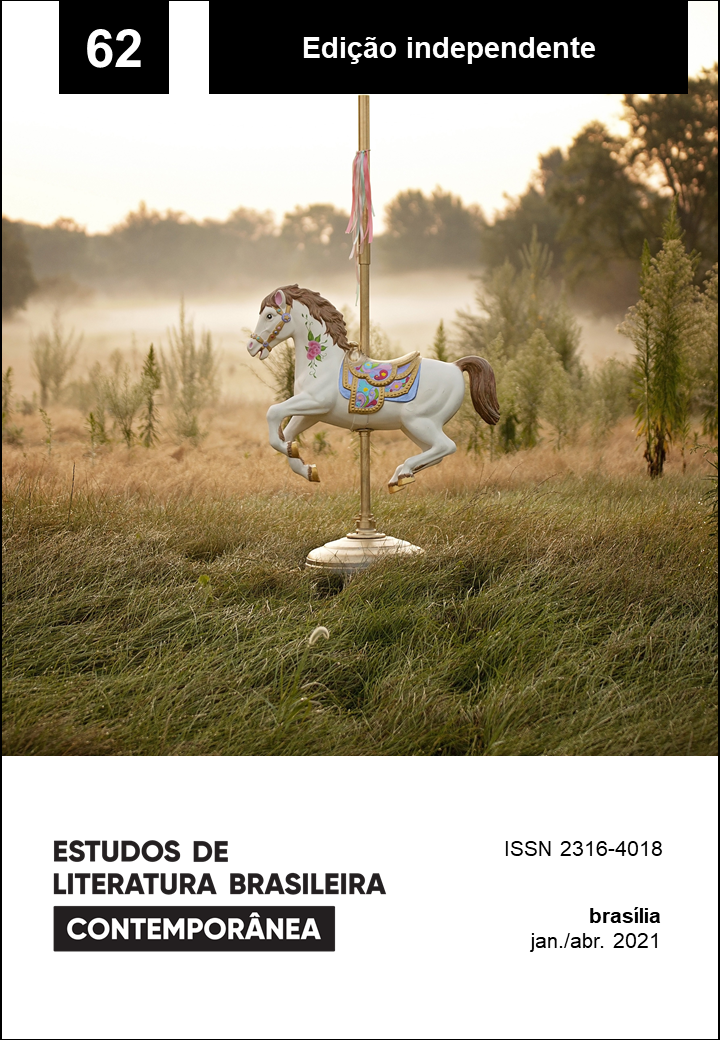New Descent into hell: Patricia Melo and the Women who Kill
DOI:
https://doi.org/10.1590/2316-4018629Keywords:
feminicide, Acre, contemporary Brazilian literature, police novelAbstract
This article reads Patrícia Melo’s Mulheres empilhadas along with O Guesa, by Sousândrade, as an organizing principle for the various plains of the novel, but especially for the one in which the forest appears as both hell and cure. From this route that goes from the urban to the forest in the context of indigenous peoples in contemporary Brazil, this text looks into the figuration of Acre as the scene of a new exoticism in recent Brazilian literature. Lastly, this article tackles the detective novel, as discussed by Josefina Ludmer in her article “Mujeres que matam,” and its look at femicide in Latin America.
Downloads
References
BOLAÑO, Roberto (2010). 2666. Tradução de Eduardo Brandão. São Paulo: Companhia das Letras.
CARMELINO, Ana Cristina; SILVEIRA, Karine (2016). O Acre não existe? Nas desnotícias, não. Linguagem em (Dis)curso, Tubarão, v. 16, n. 3, p. 433-448. Disponível em: http://www.scielo.br/pdf/ld/v16n3/1518-7632-ld-16-03-00433.pdf Acesso em: 23 mar. 2020.
DANTAS, Julia (2015). Ruína y leveza. Porto Alegre: Não Editora.
DEHÒ, Maurício (2018). "This Is Acre": Youtubers acreanos bombam brincando com "lendas" do estado. Bol, Entretenimento, 15 jun. On-line. Disponível em: http://bit.ly/3c15llM Acesso em: 23 mar. 2020.
DORRICO, Julie et al. (Org.) (2018). Literatura indígena brasileira contemporânea: criação, crítica e recepção. Porto Alegre, RS: Editora Fi.
GALERA, Daniel (Org.) (2017). Acerto de contas: treze histórias sobre crime & América Latina. Tradução de Eduardo Brandão. São Paulo: Companhia das Letras.
GONÇALVES, Filipe (2019). Mulher é assassinada por ex e tem corpo colocado em geladeira no ABC. G1, Bom dia SP, São Paulo, 19 mar. On-line. Disponível em: https://g1.globo.com/sp/sao-paulo/noticia/2019/03/19/mulher-e-assassinada-por-ex-e-tem-corpo-colocado-em-geladeira-no-abc.ghtml Acesso em: 12 jan. 2020.
LUDMER, Josefina (1996). Mulheres que matam. Revista Iberoamericana, v. LXII, n. 176-177, p. 781-797, jul./dez.
LUDMER, Josefina. (2016). Clases 1985. Algunos problemas de teoría literaria. Edição e prólogo de Annick Louis. Epublibre.
MELO, Patrícia (2019). Mulheres empilhadas. São Paulo: Leya.
SEGATO, Rita Laura (2005). Território, soberania e crimes de segundo Estado: a escritura nos corpos das mulheres de Ciudad Juarez. Rev. Estud. Fem., Florianópolis, v. 13, n. 2, p. 265-285. Disponível em: https://www.scielo.br/pdf/ref/v13n2/26882.pdf. Acesso em: 26 fev. 2020.
SOUSANDRADE, Joaquim, de (2012). O Guesa. Organização, introdução e notas de Luiza Lobo. Rio de Janeiro: Ponteio; São Luís, Maranhão: Academia Maranhense de Letras.
ZAPPI, Lucrécia (2017). Acre. São Paulo: Todavia.
Downloads
Published
How to Cite
Issue
Section
License
Copyright (c) 2021 Ieda Magri

This work is licensed under a Creative Commons Attribution-NoDerivatives 4.0 International License.
Authors who publish in this journal agree to the following terms:
a) The authors maintain the copyright and grant the journal the right of first publication, the work being simultaneously licensed under the Creative Commons Attribution License-Non Commercial 4.0 which allows the sharing of the work with acknowledgment of the authorship of the work and publication this journal.
b) Authors are authorized to enter into additional contracts separately, for non-exclusive distribution of the version of the work published in this journal (eg publish in institutional repository or as a book chapter), with authorship recognition and publication in this journal.
c) Authors are allowed and encouraged to publish and distribute their work online (eg in institutional repositories or on their personal page) after the editorial process, as this can generate productive changes, as well as increase the impact and citation of published work (See The Effect of Free Access).
d) The authors of the approved works authorize the magazine to, after publication, transfer its content for reproduction in content crawlers, virtual libraries and the like.
e) The authors assume that the texts submitted to the publication are of their original creation, being fully responsible for their content in the event of possible opposition by third parties.


